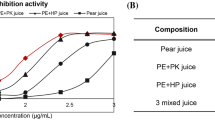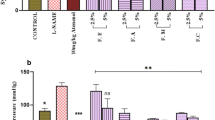Abstract
Lemon (Citrus limon) and lime (Citrus aurantifolia) juices are used in folk medicine for the management of hypertension and other cardiovascular diseases, but the mechanism of action by which they exert their therapeutic action is unclear. The aim of this study is to investigate the effect of lemon and lime juices on angiotensin-1-converting enzyme (ACE) activity in vitro and investigate the hypocholesterolemic properties of the juices in a high-cholesterol diet rat model. The phenolic content and antioxidant properties of the manually squeezed juices were also determined. Lemon juice had higher total phenol content (64.5 mg/l), while lime juice had higher total flavonoid content (29.5 mg/l). Both juices inhibited ACE activity in a dose-dependent manner and also exhibited antioxidant activities as typified by their ferric reducing power, and radicals (DPPH·, ABTS·, OH·, and NO·) scavenging abilities, as well as inhibition of Fe2+- and sodium nitroprusside-induced lipid peroxidation in rat’s liver in vitro. Administration of the juices to rats fed with a high-cholesterol diet caused a significant reduction in plasma total cholesterol, triglyceride, and LDL-cholesterol levels and an increase in plasma HDL-cholesterol levels. The inhibition of ACE activity in vitro and in vivo hypocholesterolemic effect of the juices could explain the use of the juices in the management of cardiovascular diseases.













Similar content being viewed by others
References
Actis-Goretta L, Ottaviani JI, Keen CL, Fraga CG (2003) Inhibition of angiotensin converting enzyme (ACE) activity by flavan-3-ols and procyanidins. FEBS Lett 555:597–600
Adefegha SA, Oboh G, Adefegha OM, Boligon AA, Athayde ML (2014) Antihyperglycemic, hypolipidemic, hepatoprotective and antioxidative effects of dietary clove (Szyzgium aromaticum) bud powder in a high-fat diet/streptozotocin-induced diabetes rat model. J Sci Food Agric 94(13):2726–2737
Ademosun AO, Oboh G (2012) Inhibition of acetylcholinesterase activity and Fe2+-induced lipid peroxidation in rat brain in vitro by some citrus fruit juices. J Med Food 15:1–7
Aherne SA, O’Brien MN (2002) Dietary flavonols: chemistry, food content, and metabolism. Nutrition 18:75–81
Ahnfelt-Ronne I (1991) Enzyme inhibitors as drugs. In: Krogsgaard-Larsen P, Bundgaard H (eds) A textbook of drug design and development. Harvood Academic Publishers, Switzerland, pp 302–307
Austin MA, Carolyn MH, Zimmern RL, Humphries SE (2004) Familial hypercholesterolemia and coronary heart disease: a HuGE association review. Ame J Epidemiol 160, No. 5 Johns Hopkins Bloomberg School of Public Health U.S.A. doi:10.1093/aje/kwh237
Aviram M (1993) Modified forms of low-density lipoprotein and atherosclerosis. Atherosclerosis 98:1–9
Barter P, Gotto AM, LaRosa JC, Maroni J, Szarek M, Grundy SM, Kastelein JJ, Bittner V, Fruchart JC (2007) Treating to New Targets Investigators. HDL cholesterol, very low levels of LDL cholesterol, and cardiovascular events. N Engl J Med 57:1301–1310
Belle NAV, Dalmolin GD, Fonini G, Rubim MA, Rocha JBT (2004) Polyamines reduces lipid peroxidation induced by different pro-oxidant agents. Brain Res 1008:245–251
Benderitter M, Maupoil V, Vergely C, Dalloz F, Briot F, Rochette L (1998) Studies by electron paramagnetic resonance of the importance of iron in hydroxyl scavenging properties of ascorbic acid in plasma: effects of iron chelators. Fundam Clin Pharmacol 12:510–516
Carretero OA, Oparil S (2000) Essential Hypertension Part I: definition and Etiology. Circ 101:329–335
Chapman MJ (2006) Therapeutic elevation of HDL-cholesterol to prevent atherosclerosis and coronary heart disease. Pharmacol Ther 111:893–908
Citrus Pages (2009) http://users.kymp.net/citruspages/introduction.html
Cushman DW, Cheung HS (1971) Spectrophotometric assay and properties of the Angiotensin I-converting enzyme of rabbit lung. Biochem Pharmacol 20:1637–1648
De Backer G, Ambrosioni E, Borch-Johnsen K (2003) European guidelines on cardiovascular disease prevention in clinical practice. Third Joint Task Force of European and Other Societies on Cardiovascular Disease Prevention in Clinical Practice. Eur Heart J 24:1601–1610
Dwyer J, Peterson JJ (2002) Measuring flavonoid intake: need for advanced tools. Public Health Nutr 5:925–930
Friedewald WT, Levy RI, Fredrickson DS (1972) Estimation of the concentration of low-density lipoprotein cholesterol in plasma, without use of the preparative ultracentrifuge. Clin Chem 18:499–502
Ghasemi K, Ghasemi Y, Ebrahimzadeh MA (2009) Antioxidant activity, phenol and flavonoid contents of 13 citrus species peels and tissues. Pak J Pharm Sci 3:277–281
Gil-Izquierdo A, Gil MI, Ferreres F (2002) Effect of processing techniques at industrial scale on orange juice antioxidant and beneficial health compounds. J Agric Food Chem 50:5107–5114
Gorinstein S, Caspi A, Libman I, Katrich E, Lerner HT, Trakhtenberg S (2004) Fresh Israeli Jaffa Sweetie juice consumption improves lipid metabolism and increases antioxidant capacity in hypercholesterolemic patients suffering from coronary artery disease: studies in vitro and in humans and positive Changes in albumin and fibrinogen fractions. J Agric Food Chem 52:5215–5222
Gorinstein S, Leontowicz H, Leontowicz M, Krzeminski R, Gralak M, Delgado-Licon E, Leticia A, Ayala M, Katrich E, Trakhtenberg S (2005) Changes in plasma lipid and antioxidant activity in rats as a result of naringin and red grapefruit supplementation. J Agric Food Chem 53:3223–3228
Gyamfi MA, Yonamine M, Aniya Y (1999) Free-radical scavenging action of medicinal herbs from Ghana: Thonningia sanguinea on experimentally-induced liver injuries. Gen Pharmacol 32:661–667
Hagerman AE, Riedl KM, Jones GA, Sovik KN, Ritchard NT, Hartzfeld PW, Riechel TL (1998) High molecular weight plant polyphenolics (Tannins) as biological antioxidants. J Agric Food Chem 46:1887–1892
Halliwell B (1996) Antioxidants in human health and disease. Annu Rev Nutr 16:33–50
Halliwell B, Gutterdge JMC (1981) Formation of a thiobarbituric-acid- reactive substance from deoxyribose in the presence of iron salts: the role of superoxide and hydroxyl radicals. FEBS Lett 128:347–352
Inazu A, Brown ML, Hesler CB, Agellon LB, Koizumi J, Takata K, Maruhama Y, Mabuchi H, Tall AR (1990) Increased high-density lipoprotein levels caused by a common cholesteryl-ester transfer protein gene mutation. N Engl J Med 323:1234–1238
Jang JY, Mi HK, Seok HN, Mi YK (2007) Effects of solid state fermented rice on lipid metabolism and antioxidant status in high cholesterol fed rats. J Med Food 10(4):608–614
Joshipura KJ, Hu FB, Manson JE, Stampfer MJ, Rimm EB, Speizer FE (2001) The effect of fruit and vegetable intake on risk for coronary heart disease. Ann Intern Med 134:1106–1114
Kushi LH, Folsom AR, Prineas RJ, Mink PJ, Wuv-Bustick RM (1996) Dietary antioxidant vitamins and death from coronary heart disease in postmenopausal woman. N Engl J Med 334:1156–1162.
Lakshmi Vijaya VS, Padmaja G, Kuppusamy P, Kutala VJ (2009) Oxidative stress in cardiovascular disease. Indian J Biochem Biophys 46:421–440
Lee SE, Hwang HJ, Ha JS, Jeong HS, Kim JH (2003) Screening of medicinal plant extracts for antioxidant activity. Life Sci 73:167–179
Levy D, Wilson PWF (2002) Atherosclerotic cardiovascular disease - an epidemiologic perspective. In: Topol EJ (ed) Textbook of cardiovascular medicine, 2nd edn. Lippincott Williams & Wilkins, Philadelphia, pp 13–29
Lin Y, Vermeer MA, Bos W, van Buren L, Schuurbiers E, Miret-Catalan S, Trautwein EA (2011) Molecular structures of citrus flavonoids determine their effects on lipid metabolism in HepG2 cells by primarily suppressing ApoB secretion. J Agric Food Chem 59(9):4496–4503
Lopes-Virella MF, Stone P, Ellis S, Colwell JA (1977) Cholesterol determination in high-density lipoproteins separated by three different methods. Clin Chem 23:882–884
Mabberley DJ (1997) A classification for edible Citrus (Rutaceae). Telopea 7:167–172
Mahdavi R, Nikniaz Z, Rafraf M, Jouyban A (2010) Determination and comparison of total polyphenol and vitamin C contents of natural fresh and commercial fruit juices. Pak J Nutr 9(10):968–972
Manach C, Scalbert A, Morand C, Remesy C, Jimenez L (2004) Polyphenols: food sources and bioavailability. Am J Clin Nutr 79:727–747
Marchand L (2002) Cancer preventive effects of flavonoids - a review. Biomed Pharmacother 56:296–301
Marcocci L, Marguire JJ, Droy-Lefaiz MT, Parker L (1994) The nitric oxide-scavenging properties of Gingko biloba extract EGB 761. Biochem Biophys Res Commun 210:748–755
Meda A, Lamien CE, Romito M, Millogo J, Nacoulma OG (2005) Determination of the total phenolic, flavonoid and proline contents in Burkina Faso honey, as well as their radical scavenging activity. Food Chem 91:571–577
Murray CJL, Lopez AD (1996) Global burden of disease, 1st edn. Harvard School of Public Health, Philadelphia
Nicholls SJ, Tuzcu EM, Sipahi I, Grasso AW, Schoenhagen P, Hu T, Wolski K, Crowe T, Desai MY, Hazen SL, Kapadia SR, Nissen SE (2007) Statins, high-density lipoprotein cholesterol, and regression of coronary atherosclerosis. JAMA 297:499–508
Nuovo J (2005) Ischemic heart disease. In: Taylor’s cardiovacular disease. A handbook. Springer: 23-52
Oboh G, Ademosun AO (2010) Phenolic extracts from grapefruit peels (Citrus paradisii) inhibit key enzymes linked to type-2 diabetes and hypertension. J Food Biochem. doi:10.1111/j.1745-4514.2010.00495.x
Oboh G, Ademosun AO (2011) Phenolics from orange peels (Citrus sinensis) inhibit key enzymes linked to non- insulin dependent diabetes mellitus (NIDDM) and hypertension. La Rivista Italiana Delle Sostanze Grasse 88(1):16–23
Oboh G, Rocha JBT (2007) Polyphenols in red pepper [Capsicum annuum var. aviculare (Tepin)] and their protective effect on some pro-oxidants induced lipid peroxidation in brain and liver. Eur Food Res Technol 225:239–247
Oboh G, Rocha JBT (2008) Antioxidant and neuroprotective properties of sour tea (Hibiscus sabdariffa, calyx) and green tea (Camellia sinensis) on some pro-oxidants induced lipid peroxidation in brain - in vitro. Food Biophys 3:382–389
Oboh G, Ekperigin MM, Akindahunsi AA (2005) Responses of rat liver enzymes and metabolites to diet supplemented with some Nigerian spices. Niger J Biochem Mol Biol 20(2):81–87
Oboh G, Puntel RL, Rocha JBT (2007) Hot pepper (Capsicum annuum, Tepin and Capsicum Chinese, Habanero) prevents Fe2+-induced lipid peroxidation in brain-in vitro. Food Chem 102:178–185
Oh H, Kang DG, Kwon JW, Kwon TO, Lee SY, Lee DB, Lee HB (2004) Isolation of angiotensin converting enzyme (ACE) inhibitory flavonoids from Sedum sarmentosum. Biol Pharm Bull 27:2035–2037
Okhawa H, Ohishi N, Yagi K (1979) Assay for lipid peroxides in animal tissues by thiobarbituric acid reaction. Anal Biochem 95:351–358
Oyaizu M (1986) Studies on products of browning reaction: antioxidative activity of products of browning reaction prepared from glucosamine. Jpn J Nutr 44:307–315
Pastor N, Weinstein H, Jamison E, Brenowitz M (2000) A detailed interpretation of OH radical footprints in a TBP DNA complex reveals the role of dynamics in the mechanism of sequence specific binding. J Mol Biol 304:55–68
Prior RL (2003) Fruits and vegetables in the prevention of cellular oxidative damage. Am J Clin Nutr 78:570S–578S
Puntel RL, Nogueira CW, Rocha JBT (2005) Krebs cycle intermediates modulate thiobarbituric reactive species (TBARS) production in rat brain in vitro. Neurochem Res 30:225–235
Rao AV, Rao LG (2007) Carotenoids and human health. Pharmacol Res 55:207–216
Rapisarda P, Tomaino A, Lo Cascio R, Bonina F, De Pasquale A, Saija A (1999) Antioxidant effectiveness as influenced by phenolic content of fresh orange juices. J Agric Food Chem 47:4718–4723
Re R, Pellegrini N, Proteggente A, Pannala A, Yang M, Rice-Evans C (1999) Antioxidant activity applying an improved ABTS radical cation decolorisation assay. Free Radic Biol Med 26:1231–1237
Scalbert A, Manach C, Morand C, Remesy C, Jimenez L (2005) Dietary polyphenols and the prevention of diseases. Crit Rev Food Sci Nutr 45:287–306
Silalahi J (2001) Free radicals and antioxidant vitamins in degenerative diseases. J Iondon Med Assoc 51:16–21
Singleton VL, Orthofor R, Lamuela-Raventos RM (1999) Analysis of total phenols and other oxidation substrates and antioxidants by means of Folin-Ciocalteau reagent. Methods Enzymol 299:152–178
Subash VK, Saritha G, Fareedullah MD (2010) Role of antioxidants and oxidative stress in cardiovascular diseases. Annals Biol Res 1(3):158–173
Tietz NW (1982) Fundamentals of clinical chemistry. W.B. Saunders Company, Philadelphia, pp 562–698
Tounsi MS, Wannes WA, Ouerghemmi I, Jegham S, Njima YB, Hamdaoui G, Zemni H, Marzouk B (2011) Juice components and antioxidant capacity of four Tunisian Citrus varieties. J Sci Food Agric 91:142–151
Tsutsumi Y, Shimada A, Miyano A, Nishida T, Mitsunaga T (1997) In vitro screening of angiotensin Iconverting enzyme inhibitors from Japanese cedar (Crptomera japonica). J Wood Sci 44(6):463–468
Zar JH (1984) Biostatistical analysis. Prentice-Hall Inc, New Jersey
Zhang Z, Ho WKK, Huang Y, James AE, Lam LW, Chen ZY (2002) Hawthorn fruit is hypolipidemic in rabbits fed a high cholesterol diet. J Nutr 132:5–10
Author information
Authors and Affiliations
Corresponding author
Rights and permissions
About this article
Cite this article
Oboh, G., Bello, F.O., Ademosun, A.O. et al. Antioxidant, hypolipidemic, and anti-angiotensin-1-converting enzyme properties of lemon (Citrus limon) and lime (Citrus aurantifolia) juices. Comp Clin Pathol 24, 1395–1406 (2015). https://doi.org/10.1007/s00580-015-2088-x
Received:
Accepted:
Published:
Issue Date:
DOI: https://doi.org/10.1007/s00580-015-2088-x




